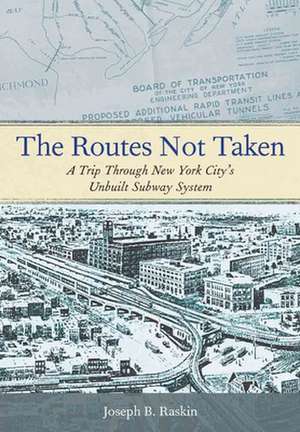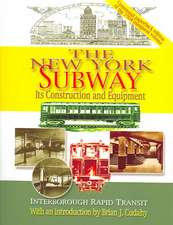The Routes Not Taken – A Trip Through New York City`s Unbuilt Subway System
Autor Joseph B. Raskinen Limba Engleză Paperback – 31 aug 2015
Robert A. Van Wyck, mayor of the greater city of New York, broke ground for the first subway line by City Hall on March 24, 1900. It took four years, six months, and twenty-three days to build the line from City Hall to West 145th Street in Harlem. Things rarely went that quickly ever again. The Routes Not Taken explores the often dramatic stories behind the unbuilt or unfinished subway lines, shedding light on a significant part of New York City's history that has been almost completely ignored until now.
Home to one of the world's largest subway systems, New York City made constant efforts to expand its underground labyrinth, efforts that were often met with unexpected obstacles: financial shortfalls, clashing agendas of mayors and borough presidents, battles with local community groups, and much more. After discovering a copy of the 1929 subway expansion map, author Joseph Raskin began his own investigation into the city's underbelly. Using research from libraries, historical societies, and transit agencies throughout the New York metropolitan area, Raskin provides a fascinating history of the Big Apple's unfinished business that until now has been only tantalizing stories retold by public-transit experts.
The Routes Not Taken sheds light on the tunnels and stations that were completed for lines that were never fulfilled: the efforts to expand the Hudson tubes into a fullfledged subway; the Flushing line, and why it never made it past Flushing; a platform underneath Brooklyn's Nevins Street station that has remained unused for more than a century; and the 2nd Avenue line long the symbol of dashed dreams deferred countless times since the original plans were presented in 1929. Raskin also reveals the figures and personalities involved, including why Fiorello LaGuardia could not grasp the importance of subway lines and why Robert Moses found them to be old and boring. By focusing on the unbuilt lines, Raskin illustrates how the existing subway system is actually a Herculean feat of countless political compromises.
Filled with illustrations of the extravagant expansion plans, The Routes Not Taken provides an enduring contribution to the transportation history of New York City.
| Toate formatele și edițiile | Preț | Express |
|---|---|---|
| Paperback (1) | 132.99 lei 3-5 săpt. | |
| ME – Fordham University Press – 31 aug 2015 | 132.99 lei 3-5 săpt. | |
| Hardback (1) | 471.87 lei 6-8 săpt. | |
| Wiley – 30 noi 2013 | 471.87 lei 6-8 săpt. |
Preț: 132.99 lei
Nou
Puncte Express: 199
Preț estimativ în valută:
25.45€ • 26.47$ • 21.01£
25.45€ • 26.47$ • 21.01£
Carte disponibilă
Livrare economică 25 martie-08 aprilie
Preluare comenzi: 021 569.72.76
Specificații
ISBN-13: 9780823267408
ISBN-10: 0823267407
Pagini: 336
Dimensiuni: 186 x 246 x 20 mm
Greutate: 0.64 kg
Editura: ME – Fordham University Press
ISBN-10: 0823267407
Pagini: 336
Dimensiuni: 186 x 246 x 20 mm
Greutate: 0.64 kg
Editura: ME – Fordham University Press
Notă biografică
Cuprins
Contents 1. Building (and Not Building) New York City's Subway System 2. Sound to Shore - The Unbuilt Brooklyn Queens Crosstown Line 3. Why the No. 7 Line Stops in Flushing 4. The Battle of the Northeast Bronx - 1 5. Buy Land Now, Ride the Subway Later 6. Ashland Place and the Mysteries of 76th Street 7. To the City Limits and Beyond 8. The Battle of the Northeast Bronx - 2 9. Building the Line That Almost Never Was 10. Other Plans, Other Lines, Other Issues in the Postwar Years 11. What Happened to the Rest of the System??? Appendix 1. The 1944 Service Plan Appendix 2. The 1947 2nd Avenue Service Plan Notes Bibliography Index
Recenzii
"This is an extraordinary and magisterial book, the product of years of diligent research on a topic that has been almost completely ignored, but one central to the understanding of the evolution of New York City in the twentieth century."-Peter Eisenstadt
"This is an extraordinary and magisterial book, the product of years of diligent research on a topic that has been almost completely ignored, but one central to the understanding of the evolution of New York City in the twentieth century."-Peter Eisenstadt
"This is an extraordinary and magisterial book, the product of years of diligent research on a topic that has been almost completely ignored, but one central to the understanding of the evolution of New York City in the twentieth century."-Peter Eisenstadt







